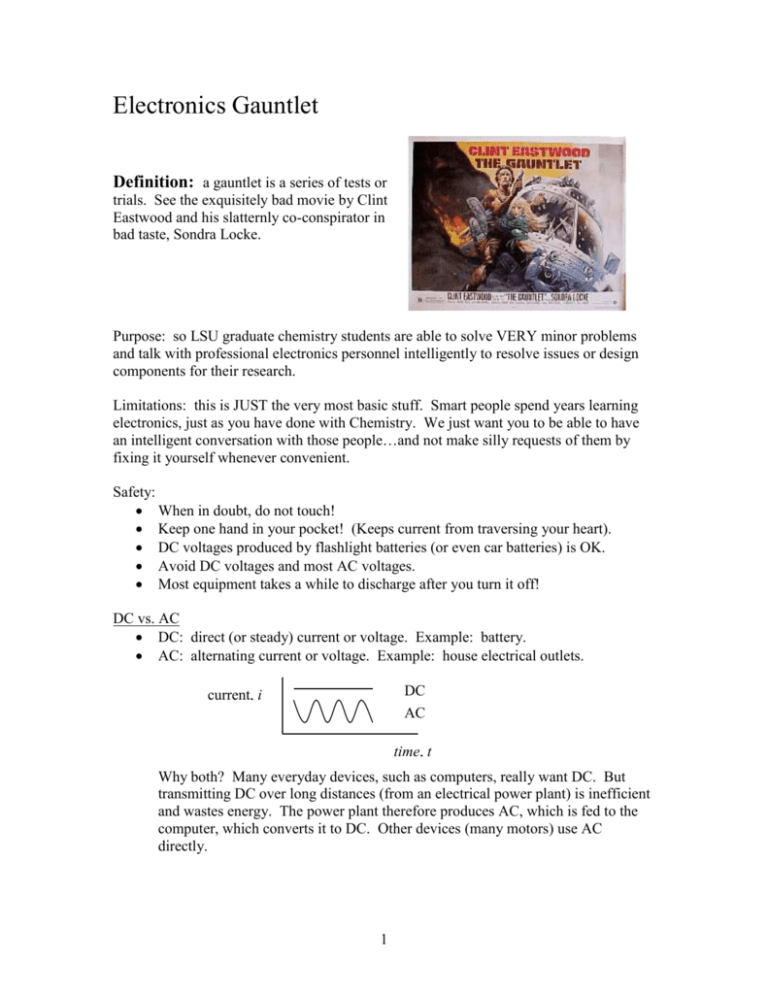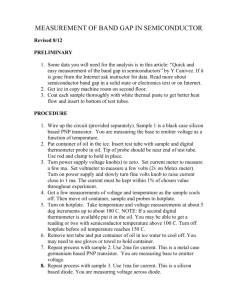LSU SaturChem Electronics Gauntlet
advertisement

Electronics Gauntlet Definition: a gauntlet is a series of tests or trials. See the exquisitely bad movie by Clint Eastwood and his slatternly co-conspirator in bad taste, Sondra Locke. Purpose: so LSU graduate chemistry students are able to solve VERY minor problems and talk with professional electronics personnel intelligently to resolve issues or design components for their research. Limitations: this is JUST the very most basic stuff. Smart people spend years learning electronics, just as you have done with Chemistry. We just want you to be able to have an intelligent conversation with those people…and not make silly requests of them by fixing it yourself whenever convenient. Safety: When in doubt, do not touch! Keep one hand in your pocket! (Keeps current from traversing your heart). DC voltages produced by flashlight batteries (or even car batteries) is OK. Avoid DC voltages and most AC voltages. Most equipment takes a while to discharge after you turn it off! DC vs. AC DC: direct (or steady) current or voltage. Example: battery. AC: alternating current or voltage. Example: house electrical outlets. DC AC current, i time, t Why both? Many everyday devices, such as computers, really want DC. But transmitting DC over long distances (from an electrical power plant) is inefficient and wastes energy. The power plant therefore produces AC, which is fed to the computer, which converts it to DC. Other devices (many motors) use AC directly. 1 Units Reminders Quantity Symbol Unit Charge Usually q or Q Current: i or I Potential: Resistance: V R Capacitance: Inductance: C L Coulombs (too bad—other units would make more sense) ampere (one coulomb per second) volts (one Joule per coulomb) ohms (one volts per ampere, or JoulesecCoulomb-2) farads (one Coulomb per volt henry (volt-sec per ampere) Unit Symbol C A V F H Some relations V = IR (voltage equals current times resistance) P = IV (power in watts is current in amperes times voltage in volts) P = I2R P = V2/R C = Q/V (capacitance descries how much charge you can hold in the device—it’s capacity!—for each volt applied) V = L (di/dt) (voltages build up when the current changes—one reason it is hard to make faster and faster computers). 2 Components Electron-controlling devices, or electronic components, can be divided into “passive” and “active”. Passive: no power gain as the electrons flow through (resistors, capacitors, inductors). Active: able to control the amount of electrons flowing (diodes, transistors, etc.) Symbols In diagrams of electrical devices, the various components are indicated by symbols. Below is a picture of some resistors and the symbol: In this Gauntlet, we are just going to show you how some components look. For more symbols and pictures of components, see: http://webhome.idirect.com/~jadams/electronics/oldindex.htm Values Component values are usually indicated on the device—e.g. 50 F for a 50 x 10-6 Farad capacitor. Resistors follow a color code: The approximate value of a resistor can be determined from its color code, as shown below: Third Band First Band Example: a resistor whose bands are red, orange, yellow and gold is: 23 104 5% (i.e., 230 k) Fourth Band Second Band 3 Resistor Color Table Color First Band Second Band Third Band black brown red orange yellow green blue violet gray white gold silver 0 1 2 3 4 5 6 7 8 9 --- 0 1 2 3 4 5 6 7 8 9 --- 100 101 102 103 104 105 106 107 108 109 10-1 10-2 Fourth band: Silver is: Gold is: no band is: 10% 5% tolerance 20% tolerance This table taken from: Diefenderfer: Principles of Electronic Instruments, Saunders: Philadelphia, 1972. Call # TK7878.4 D5 Circuits Electrons flow from regions of high to low potential. The voltage change all the way around such a circuit is zero (one of the Kirchoff’s laws from your Physics class). We don’t need to know much about circuits here, but this one should look familiar: i R1 R2 The battery on the left side provides counterclockwise current and a voltage, V. The resistors, R1 and R2, provide voltage drops V1= iR1 and V2 = iR2, respectively. The total voltage around the loop is zero: V - iR1 - iR2 = 0. You will use this circuit to reduce a voltage in one of the gauntlets. 4 Gauntlet Part #1a: Passive Components Into the rectangle, place five samples of the component that follows the equation shown. Equation: V = IR 5 Place this paper next to the page holding the passive components that follow this type of frequency response curve: Gain Hz 6 Gauntlet Part #1b: Passive Components Into the rectangle, place five samples of the component that follows the equation shown. Equation: C = Q/V 7 Place this paper next to the page holding the passive components that follow a frequency response curve like this: Gain Hz 8 Gauntlet Part #1c: Passive Components Into the rectangle, place five samples of the component that follows the equation shown. Equation: V = L (di/dt) 9 Place this paper next to the page holding the components that follow this frequency response curve: Gain Hz 10 Put this symbol next to the correct components & frequency response curve 11 Put this symbol next to the correct components & frequency response curve 12 Put this symbol next to the correct components & frequency response curve 13 Gauntlet Part 2: Identifying a blown fuse. An instrument that was working yesterday suddenly stopped. After unplugging, it was opened up and the following four fuses identified. Checking fuses is the first thing to try! In this case, only one of the four fuses was bad. Which one? A B C D Fuse hints: you can SOMETIMES tell if a fuse is broken just by looking. But fuses that sometimes LOOK good are NOT. You should always test good-looking fuses with a meter. Always replace the fuse with one of the same value and speed (for old gear, try to check that the correct fuse was installed—i.e., that nobody screwed up before you got to the instrument). If the fuse blows again quickly, something more serious is wrong. Get help! The voltage rating on fuses just indicates the normal operating voltage maximum: the fuse will not arc at voltages lower than the indicated. It is current, not voltage, that causes the fuse to blow. Fuses have other shapes, but the simple cylindrical ones above are common. 14 Gauntlet, Part #3. How much heat? If the Variac is doubled from 20 to 40, how much does the rate of heat production increase? 15 Gauntlet Part #4. Measure that voltage! In some applications, a signal exceeds what your meter (or oscilloscope, or the A-D card in your computer) can measure. You may have to passively cut the voltage down. WITHOUT TWIDDLING THE METER (or oscilloscope knobs or A-D card settings) make a circuit that enables you to get this reading. Application note: a typical application of this resistive network is to operate a photodetector in its optimum range. A very sensitive detector may produce too much voltage for a computer A-D to read it correctly. It’s tempting to reduce the light striking the detector, but this may just lower the signal down into the (constant) noise range. It’s better to let the 16 detector produce a large voltage well above the noise….and measure a part of that large signal. 17 Gauntlet Part #5a: Active Components Into the rectangle, place one or more samples of the component listed below. Transistors (mnemonic: transistors, like tripods, have three feet) 18 Gauntlet Part #5b: Active Components Into the rectangle, place one or more samples of the component listed below. Operational Amplifiers 19 Gauntlet Part #5c: Active Components Into the rectangle, place one or more samples of the component listed below. Diodes 20 Gauntlet Part #5 (Place the cutouts on the page with the appropriate components) i V Several are Electronic used to “checkvalve” convert AC to DC 21 i C B V E Electronic Stopcock A small applied signal results in huge output change Not all that different from First invented tubes, or as 1923 the British Forgotten call them, Reinvented Valves ~1948 22 Changing resistors attached to pins affects gain. Easily used to add, differentiate, multiply, etc. Integrated Circuit 23 Typically Can cure contains 20 impedance Transistors and mismatches, 11 Resistors, making less than $1 instruments more compatible. Introduced 1968 741 24 Gauntlet Part #6: THE MIT TEST A study showed that most MIT engineers could NOT make a flashlight! Said one, “I’m a mechanical engineer!” Using the components below, assemble a flashlight with a working switch. 25 Gauntlet Part #7 Woofer Tester The woofer tester is used to guess at the contents of some passive components in a sealed, black box. Students are encouraged to guess it first, then open to see if they got the components right. They may try various other components in series, parallel, etc. 26 Appendix: AC Circuits In the above, we mostly just have component identification and hints of the theory—e.g., voltage across inductor = Ldi/dt. It makes good sense for polymer people to study a little AC circuit theory, because it echoes the development of rheology. A very nice web reference for AC circuits appears here: http://www.phys.unsw.edu.au/~jw/AC.html 27 Appendix: TA Prep Notes Requires soldering irons, solder boxes of passive/active components batteries switches lightbulbs variac heating mantle printouts of the gauntlet blown fuses with tape over them optional: mystery components potted in clay; use frequency response or phase to determine what they are. Set up a signal generator feeding an oscilloscope; set the input to be too large for the oscilloscope. Have resistors and a potentiostat nearby, so students can construct voltage divider circuit. Let the experiment with inductors and capacitors, too. 28







